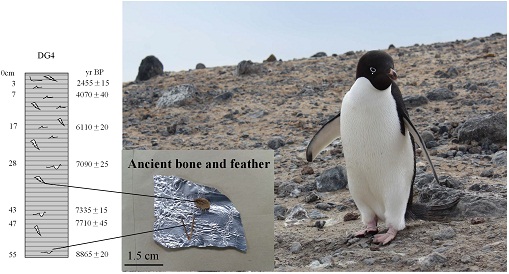Modern krill stocks have been estimated directly by net hauls and acoustic surveys. But how can people know the historical krill density, especially the long-term one prior to human intervenes? It is far from easy. Fortunately, with the novel method developed by the research group led by Prof. SUN Liguang from the University of Science and Technology of China (USTC), the relative krill abundance in East Antarctica during the Holocene is no longer a mystery to human beings.
A team of researchers led by Prof. SUN Liguang and HUANG Tao from the Institute of Polar Environment, School of Earth and Space Sciences of USTC, inferred the relative krill abundance during the Holocene epoch from paleodiets of Adelie penguin, using inverse of δ15N value as a proxy. The discovery provides crucial information for understanding and predicting response of krill population to natural climate changes as well as preservation of Ecological resources in the Southern Ocean.
Supporting a large number of upper trophic-level predators, Antarctic krill is a key component of the Southern Ocean food web and a substantial commercial fishery resource. The abundance of krill is very sensitive to climate change and has significant impacts on high trophic-level predators in the Southern Ocean ecosystems. However, the existed krill population data can only be treated back to about 100 years ago and the long-term historical krill abundance prior to human intervenes remains unknown. Adelie penguin, similar to Antarctic fur seal, is an important land-based krill predator. Considering the wide availability of continuous and long time-series remains of Adelie penguin that could easily be preserved in various lake sediments, it is an ideal indicator for tracking krill abundance over a long period of time.

Fig:Ade′lie penguin in the Vestfold Hills and the bones and feathers from the sediment core DG4 profile with conventional AMS 14C dates25 (yrBP: years before present)./ Photo by HUANG Tao.
By performing stable isotope analyses on ancient Adelie penguin tissues and using inverse of δ15N value as a proxy, the relative krill abundance during the Holocene epoch was inferred from the paleodiets of Adelie penguin. Variations in krill abundance during the Holocene are discovered to be in accord with episodes of regional climate changes and krill surplus in modern ages are suggested to be caused by recent hunt for krill eating seals and whales by humans.
The novel method created by Prof. SUN's group makes it possible to infer past krill population changes from ancient tissues of krill predators and opens a new way in the field of studying historical population changes of species living in ocean over time.
(TIAN Lin, USTC News Center)